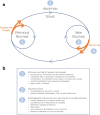How to fall into a new routine: factors influencing the implementation of an admission and discharge programme in hospitals and general practices
- PMID: 36284324
- PMCID: PMC9598008
- DOI: 10.1186/s12913-022-08644-5
How to fall into a new routine: factors influencing the implementation of an admission and discharge programme in hospitals and general practices
Abstract
Introduction: The VESPEERA programme is a multifaceted programme to enhance information transfer between general practice and hospital across the process of hospital admission, stay and discharge. It was implemented in 7 hospitals and 72 general practices in Southern Germany. Uptake was heterogeneous and overall low. A process evaluation aimed at identifying factors associated with the implementation of the VESPEERA programme.
Methods: This was a qualitative study using semi-structured interviews in a purposeful sample of health workers in hospitals and general practices in the VESPEERA programme. Qualitative framework analysis using the Consolidated Framework for Implementation Research was performed and revealed the topic of previous and new routines to be protruding. Inductive content analysis was used for in-depth examination of stages in the process of staying in a previous or falling into a new routines.
Results: Thirty-six interviews were conducted with 17 participants from general practices and 19 participants from hospitals. The interviewees were in different stages of the implementation process at the time of the interviews. Four stages were identified: Stage 1,'Previous routine and tension for change', describes the situation in which VESPEERA was to be implemented and the factors leading to the decision to participate. In stage 2,'Adoption of the VESPEERA programme', factors that influenced whether individuals decided to employ the innovation are relevant. Stage 3 comprises 'Determinants for falling into and staying in the new VESPEERA-routine' relates to actual implementation and finally, in stage 4, the participants reflect on the success of the implementation.
Conclusions: The individuals and organisations participating in the VESPEERA programme were in different stages of a process from the previous to the new routine, which were characterised by different determinants of implementation. In all stages, organisational factors were main determinants of implementation, but different factors emerged in different implementation stages. A low distinction between decision-making power and executive, as well as available resources, were beneficial for the implementation of the innovation.
Trial registration: DRKS00015183 on DRKS / Universal Trial Number (UTN): U1111-1218-0992.
Keywords: Admission management; Discharge management; General practice; Hospital; Implementation; Middle management; Routine.
© 2022. The Author(s).
Conflict of interest statement
The authors declare that they have no competing interest.
Figures
References
MeSH terms
LinkOut - more resources
Full Text Sources



